Effect of Different Cooling Strategies on Surface Quality and Power Consumption in Finishing End Milling of Stainless Steel 316
Abstract
1. Introduction
2. Materials and Methods
2.1. Material Specifications
2.2. Machining of Test Specimens
2.3. Measuring Systems
2.4. Test Procedures
2.5. Cooling Conditions
3. Results and Discussion
3.1. Effect of Cooling Strategies on Power Consumption
3.2. Effect of Cooling Strategies on Surface Roughness
3.3. Effect of Cooling Strategies on Surface Integrity
4. Conclusions
- A decrease in power consumption was found by machining with MQL and MQL + Al2O3 compared to dry case by 4.7% and 8.6% in average, respectively.
- Higher improvement in surface roughness was obtained by machining with the two types of MQL lubricant conditions compared to dry condition while the difference in generated surface roughness obtained by using MQL and MQL + Al2O3 conditions was small. The improvement in surface roughness in the cases of MQL and MQL + Al2O3 found to be 40% and 44% in average, respectively, compared to dry case.
- Power consumption was found to increase with increasing cutting speed and feed rate, and the influence of the cutting speed was higher than that obtained by feed rate at all types of coolant, while at dry condition, neglectable influencing of feed rate was found on power consumption.
- It was found that improvement in surface roughness when using MQL + Al2O3 compared to dry condition was increased from 34% to 64% when cutting speed changed from 30 m/min to 120 m/min at constant value of feed rate, and this improvement was from 28% to 41% when feed rate changed from 25 mm/min to 100 mm/min at constant value of cutting speed. Therefore, the benefits of using MQL and MQL + Al2O3 coolants increased at higher cutting speed and feed rate, thus higher productivity was achieved without higher deterioration in the surface roughness compared to dry conditions.
- Adhered material, debris, furrows, plastic deformation, and bores were found in the surface texture characterized by SEM when machining with dry condition. A smoother surface with nano-polishing effect was found in the case of MQL+ Al2O3, and friction marks were observed when machining with MQL comparable with the case of MQL + Al2O3.
Author Contributions
Funding
Institutional Review Board Statement
Informed Consent Statement
Data Availability Statement
Acknowledgments
Conflicts of Interest
References
- Ha, H.-Y.; Lee, T.-H.; Bae, J.-H.; Chun, D.W. Molybdenum Effects on Pitting Corrosion Resistance of FeCrMnMoNC Austenitic Stainless Steels. Metals 2018, 8, 653. [Google Scholar] [CrossRef]
- Uysal, A.; Demiren, F.; Altan, E. Applying Minimum Quantity Lubrication (MQL) Method on Milling of Marten-sitic Stainless Steel by Using Nano Mos2 Reinforced Vegetable Cutting Fluid. Procedia Soc. Behav. Sci. 2015, 195, 2742–2747. [Google Scholar] [CrossRef]
- Kaladhar, M.; Subbaiah, K.V.; Rao, C.S. Machining of austenitic stainless steels—A review. Int. J. Mach. Mach. Mater. 2012, 12, 178. [Google Scholar] [CrossRef]
- Abbas, A.T.; El Rayes, M.M.; Luqman, M.; Naeim, N.; Hegab, H.; Elkaseer, A. On the Assessment of Surface Quality and Productivity Aspects in Precision Hard Turning of AISI 4340 Steel Alloy: Relative Performance of Wiper vs. Conventional Inserts. Materials 2020, 13, 2036. [Google Scholar] [CrossRef]
- Khan, A.A.; Ahmed, M.I. Improving tool life using cryogenic cooling. J. Mater. Process. Technol. 2008, 196, 149–154. [Google Scholar] [CrossRef]
- Verma, V.; Kumar, J.; Singh, A. Optimization of material removal rate and surface roughness in turning of 316 steel by using full factorial method. In Proceedings of the Materials Today: Proceedings; Elsevier: Greater Noida, India, 2020; Volume 25, pp. 793–798. [Google Scholar]
- Abou-El-Hossein, K.; Yahya, Z. High-speed end-milling of AISI 304 stainless steels using new geometrically developed carbide inserts. J. Mater. Process. Technol. 2005, 596–602. [Google Scholar] [CrossRef]
- Liew, W.; Ding, X. Wear progression of carbide tool in low-speed end milling of stainless steel. Wear 2008, 265, 155–166. [Google Scholar] [CrossRef]
- Abou-El-Hossein, K. Cutting fluid efficiency in end milling of AISI 304 stainless steel. Ind. Lubr. Tribol. 2008, 60, 115–120. [Google Scholar] [CrossRef]
- Gunjal, S.U.; Patil, N.G. Experimental Investigations into Turning of Hardened AISI 4340 Steel using Vegetable based Cutting Fluids under Minimum Quantity Lubrication. Procedia Manuf. 2018, 20, 18–23. [Google Scholar] [CrossRef]
- Shokrani, A.; Dhokia, V.; Newman, S.T. Environmentally conscious machining of difficult-to-machine materials with regard to cutting fluids. Int. J. Mach. Tools Manuf. 2012, 57, 83–101. [Google Scholar] [CrossRef]
- Debnath, S.; Reddy, M.M.; Yi, Q.S. Environmental friendly cutting fluids and cooling techniques in machining: A review. J. Clean. Prod. 2014, 83, 33–47. [Google Scholar] [CrossRef]
- Abbas, A.T.; Anwar, S.; Hegab, H.; Benyahia, F.; Ali, H.; Elkaseer, A. Comparative Evaluation of Surface Quality, Tool Wear, and Specific Cutting Energy for Wiper and Conventional Carbide Inserts in Hard Turning of AISI 4340 Alloy Steel. Materials 2020, 13, 5233. [Google Scholar] [CrossRef]
- Khatri, A.; Jahan, M.P. Investigating tool wear mechanisms in machining of Ti-6Al-4V in flood coolant, dry and MQL conditions. Procedia Manuf. 2018, 26, 434–445. [Google Scholar] [CrossRef]
- Katoh, T.; Ohmori, S.; Maeda, T.; Kakumitsu, T.; Okuda, K.; Sekimoto, M.; Morigo, C. Effect of High-Pressure Coolant Supply on Chip-Breaking and Tool Wear in Machining of Stainless Steel. Key Eng. Mater. 2015, 656, 226–230. [Google Scholar] [CrossRef]
- Stolf, P.; Paiva, J.M.; Ahmed, Y.S.; Endrino, J.L.; Goel, S.; Veldhuis, S.C. The role of high-pressure coolant in the wear characteristics of WC-Co tools during the cutting of Ti–6Al–4V. Wear 2019, 440, 203090. [Google Scholar] [CrossRef]
- Sharma, A.K.; Tiwari, A.K.; Dixit, A.R. Effects of Minimum Quantity Lubrication (MQL) in machining processes using conventional and nanofluid based cutting fluids: A comprehensive review. J. Clean. Prod. 2016, 127, 1–18. [Google Scholar] [CrossRef]
- Sarikaya, M.; Gupta, M.K.; Tomaz, I.; Danish, M.; Mia, M.; Rubaiee, S.; Jamil, M.; Pimenov, D.Y.; Khanna, N. Cooling techniques to improve the machinability and sustainability of light-weight alloys: A state-of-the-art review. J. Manuf. Proc. 2021, 62, 179–201. [Google Scholar] [CrossRef]
- Giasin, K.; Ayvar-Soberanis, S.; Hodzic, A. Evaluation of cryogenic cooling and minimum quantity lubrication effects on machining GLARE laminates using design of experiments. J. Clean. Prod. 2016, 135, 533–548. [Google Scholar] [CrossRef]
- Shen, B.; Shih, A.J.; Tung, S.C. Application of Nanofluids in Minimum Quantity Lubrication Grinding. Tribol. Trans. 2008, 51, 730–737. [Google Scholar] [CrossRef]
- Shen, B.; Kalita, P.; Malshe, A.P.; Shih, A.J. Performance of Novel MoS2 Nanoparticles Based Grinding Fluids in Minimum Quantity Lubrication Grinding; Transactions of the North American Manufacturing Research Institution of SME: Evanston, IL, USA, 2008. [Google Scholar]
- Rahmati, B.; Sarhan, A.A.D.; Sayuti, M. Morphology of surface generated by end milling AL6061-T6 using mo-lybdenum disulfide (MoS2) nanolubrication in end milling machining. J. Clean. Prod. 2014, 66, 685–691. [Google Scholar] [CrossRef]
- Nam, J.S.; Lee, P.-H.; Lee, S.W. Experimental characterization of micro-drilling process using nanofluid minimum quantity lubrication. Int. J. Mach. Tools Manuf. 2011, 51, 649–652. [Google Scholar] [CrossRef]
- Setti, D.; Sinha, M.K.; Ghosh, S.; Rao, P.V. Performance evaluation of Ti–6Al–4V grinding using chip formation and coefficient of friction under the influence of nanofluids. Int. J. Mach. Tools Manuf. 2015, 88, 237–248. [Google Scholar] [CrossRef]
- Alberts, M.; Kalaitzidou, K.; Melkote, S. An investigation of graphite nanoplatelets as lubricant in grinding. Int. J. Mach. Tools Manuf. 2009, 49, 966–970. [Google Scholar] [CrossRef]
- Li, M.; Yu, T.; Zhang, R.; Yang, L.; Ma, Z.; Li, B.; Wang, X.; Wang, W.; Zhao, J. Experimental evaluation of an eco-friendly grinding process combining minimum quantity lubrication and graphene-enhanced plant-oil-based cutting fluid. J. Clean. Prod. 2019, 244, 118747. [Google Scholar] [CrossRef]
- Mao, C.; Zou, H.; Zhou, X.; Huang, Y.; Gan, H.; Zhou, Z. Analysis of suspension stability for nanofluid applied in minimum quantity lubricant grinding. Int. J. Adv. Manuf. Technol. 2014, 71, 2073–2081. [Google Scholar] [CrossRef]
- Jeng, H.A.; Swanson, J. Toxicity of Metal Oxide Nanoparticles in Mammalian Cells. J. Environ. Sci. Health Part A 2006, 41, 2699–2711. [Google Scholar] [CrossRef] [PubMed]
- Lee, P.-H.; Nam, J.S.; Li, C.; Lee, S.W. An experimental study on micro-grinding process with nanofluid minimum quantity lubrication (MQL). Int. J. Precis. Eng. Manuf. 2012, 13, 331–338. [Google Scholar] [CrossRef]
- Bai, X.; Li, C.; Dong, L.; Yin, Q. Experimental evaluation of the lubrication performances of different nanofluids for minimum quantity lubrication (MQL) in milling Ti-6Al-4V. Int. J. Adv. Manuf. Technol. 2019, 101, 2621–2632. [Google Scholar] [CrossRef]
- Ali, M.A.M.; Azmi, A.I.; Khalil, A.N.M.; Leong, K.W. Experimental study on minimal nanolubrication with surfactant in the turning of titanium alloys. Int. J. Adv. Manuf. Technol. 2017, 92, 117–127. [Google Scholar] [CrossRef]
- Rahman, S.S.; Ashraf, Z.I.; Amin, A.N.; Bashar, M.; Ashik, F.K.; Kamruzzaman, M. Tuning nanofluids for improved lubrication performance in turning biomedical grade titanium alloy. J. Clean. Prod. 2019, 206, 180–196. [Google Scholar] [CrossRef]
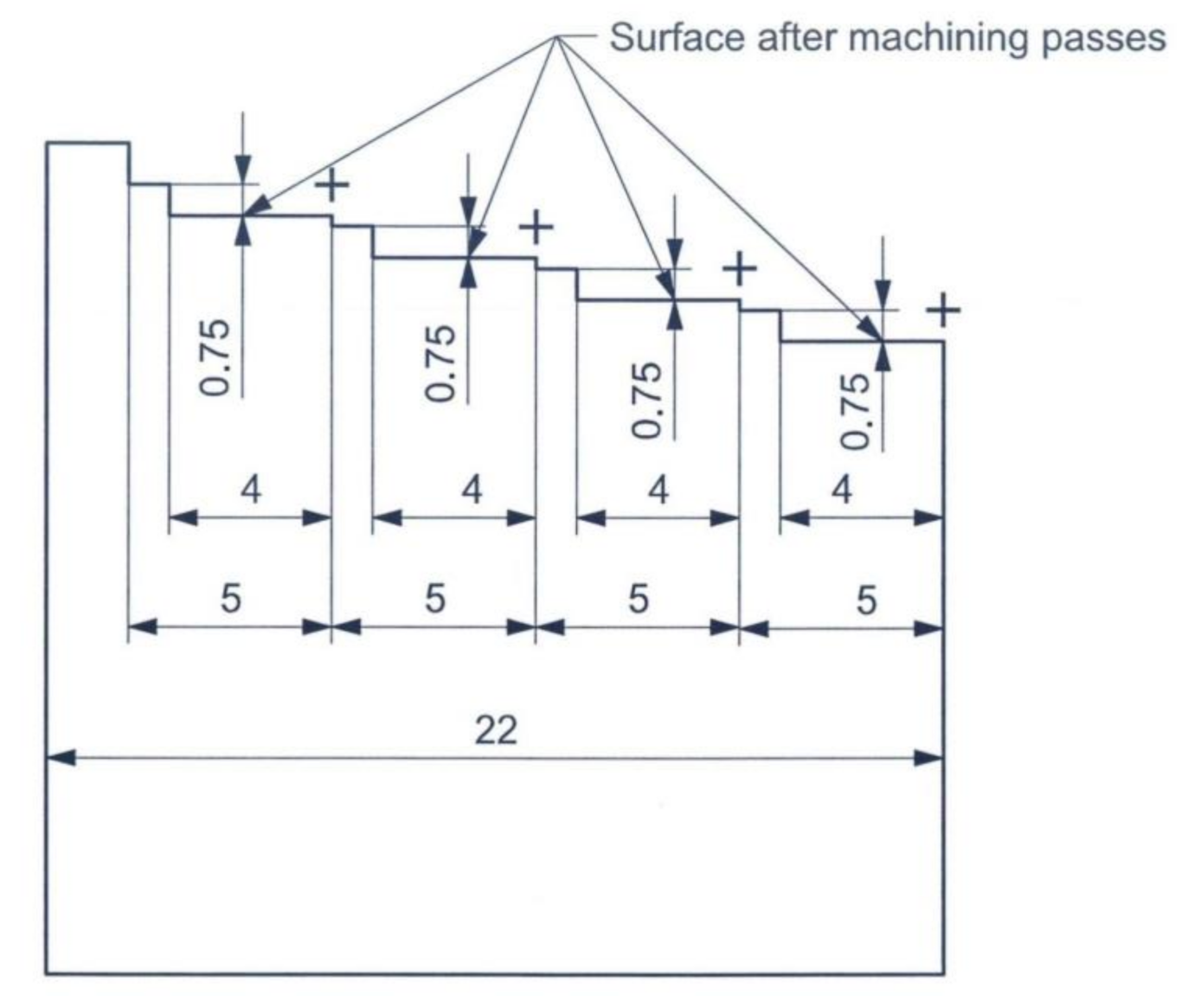
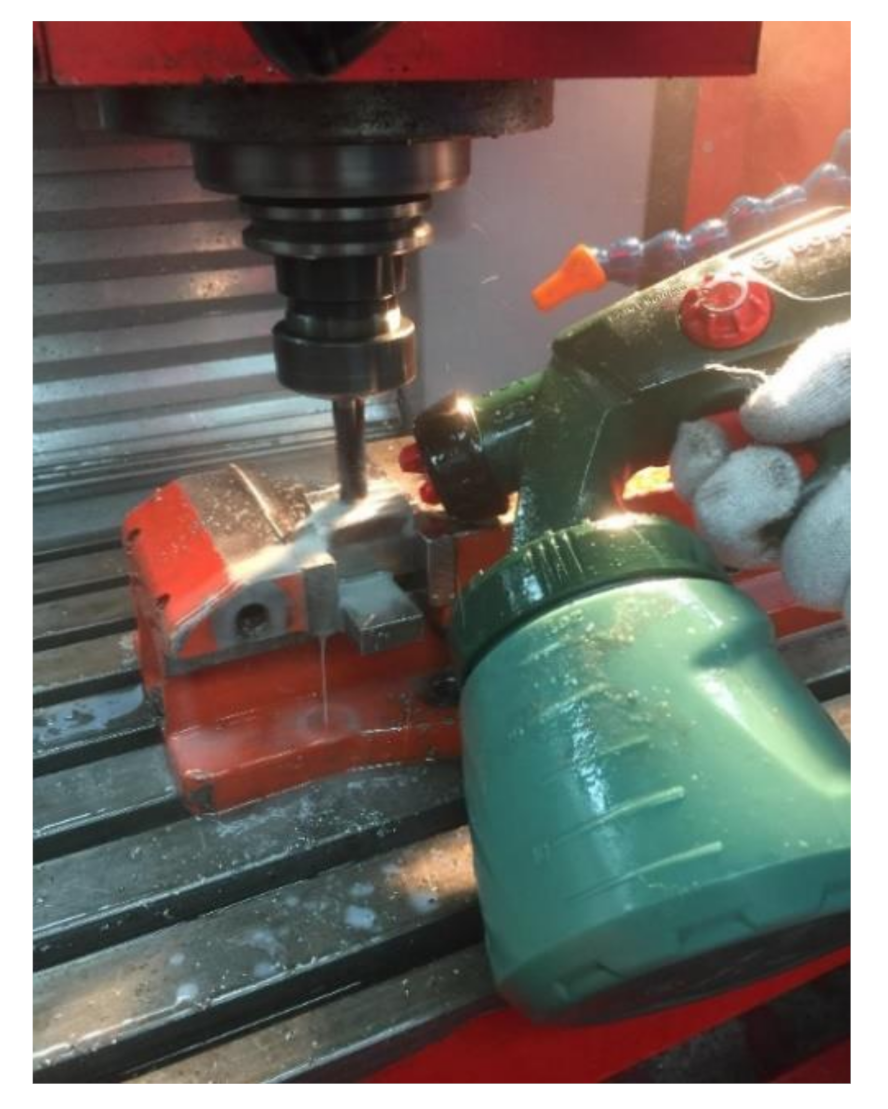
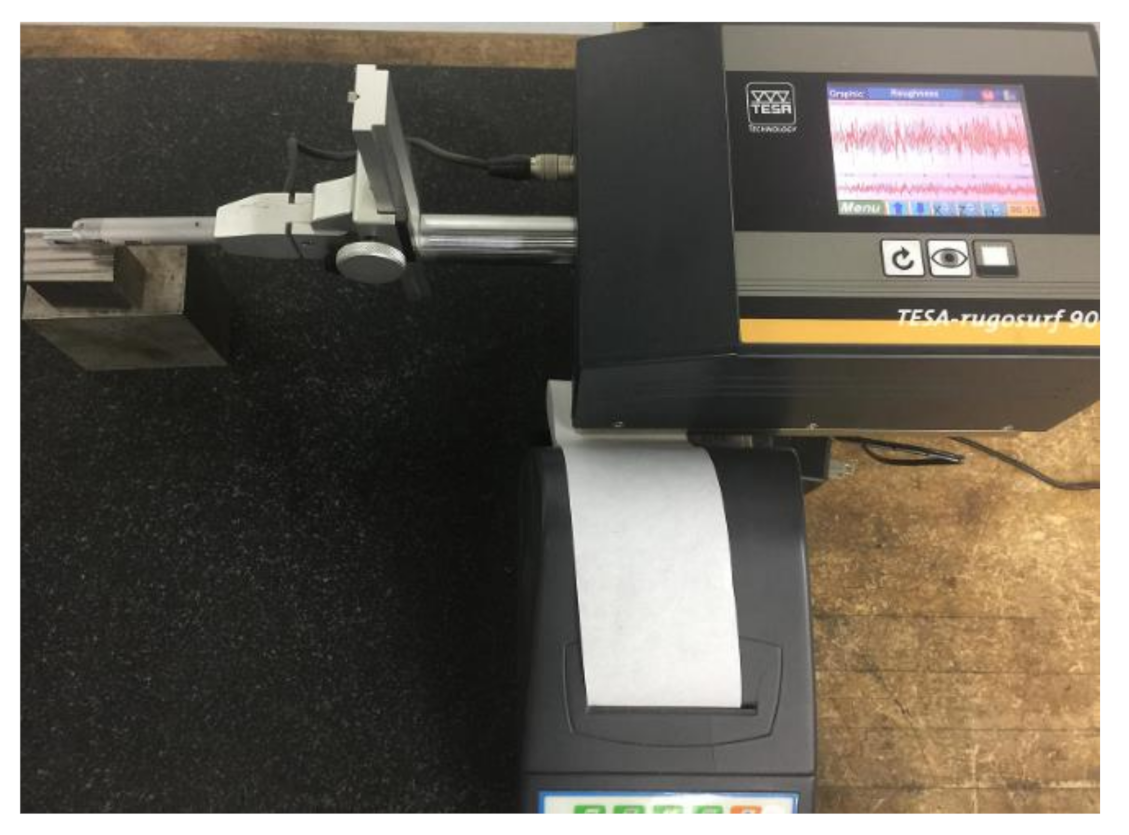
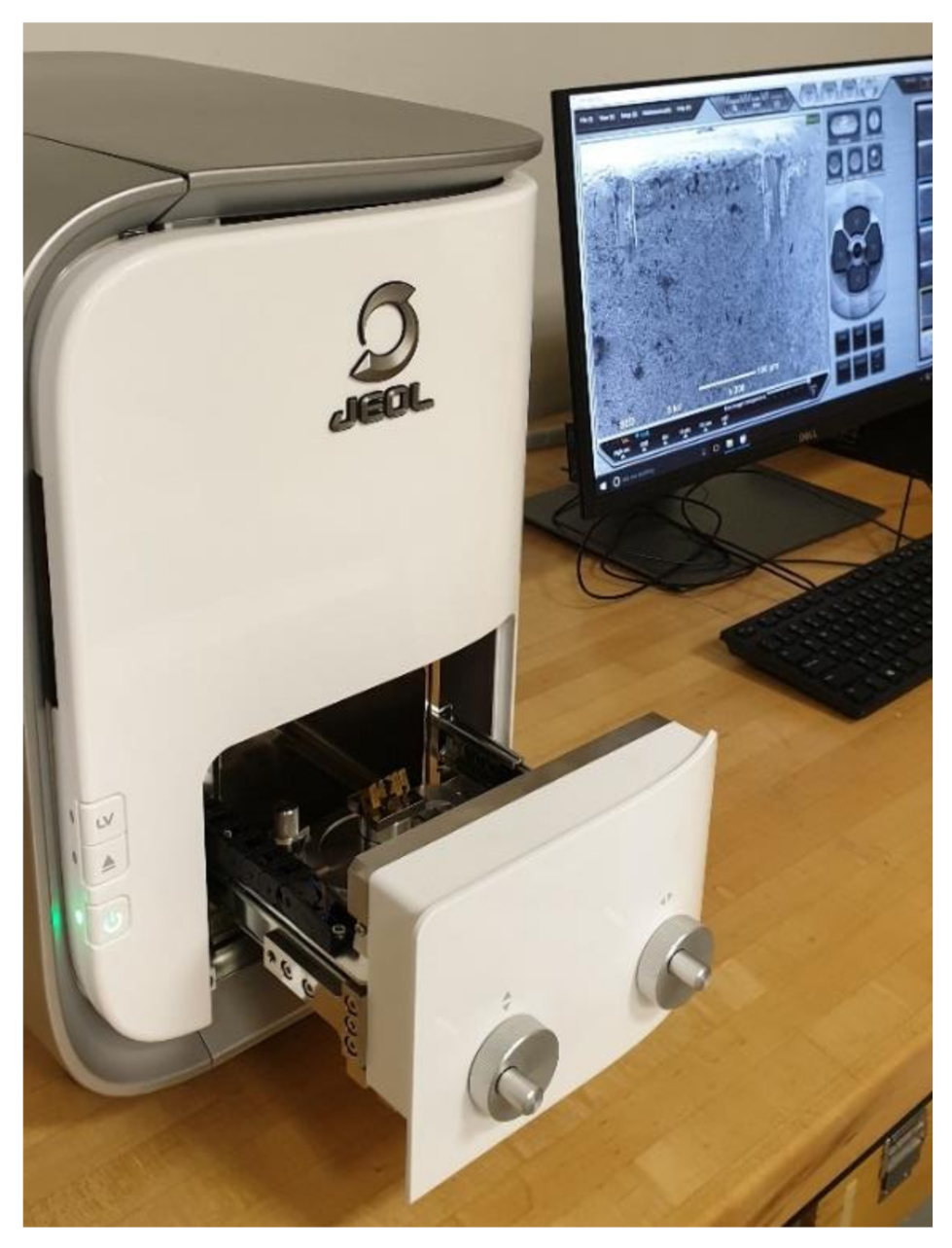
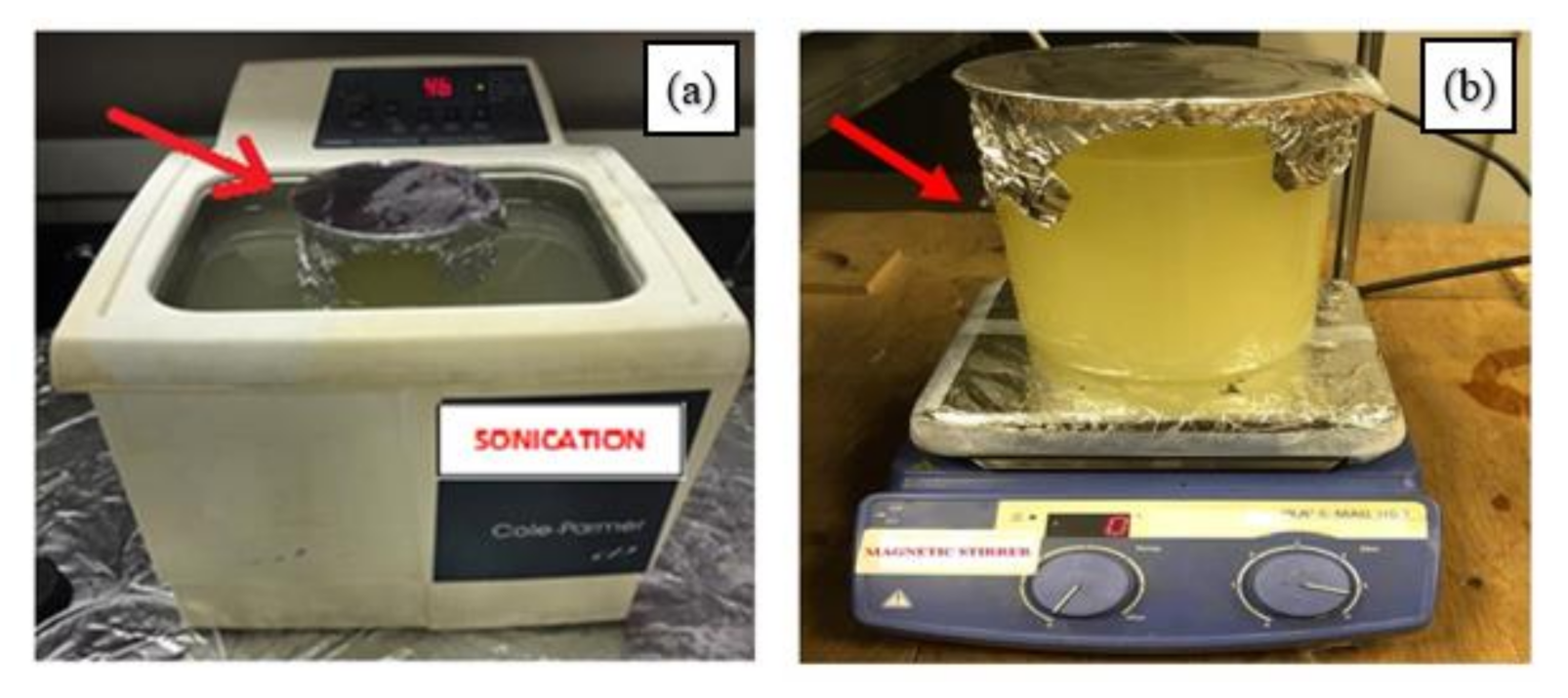
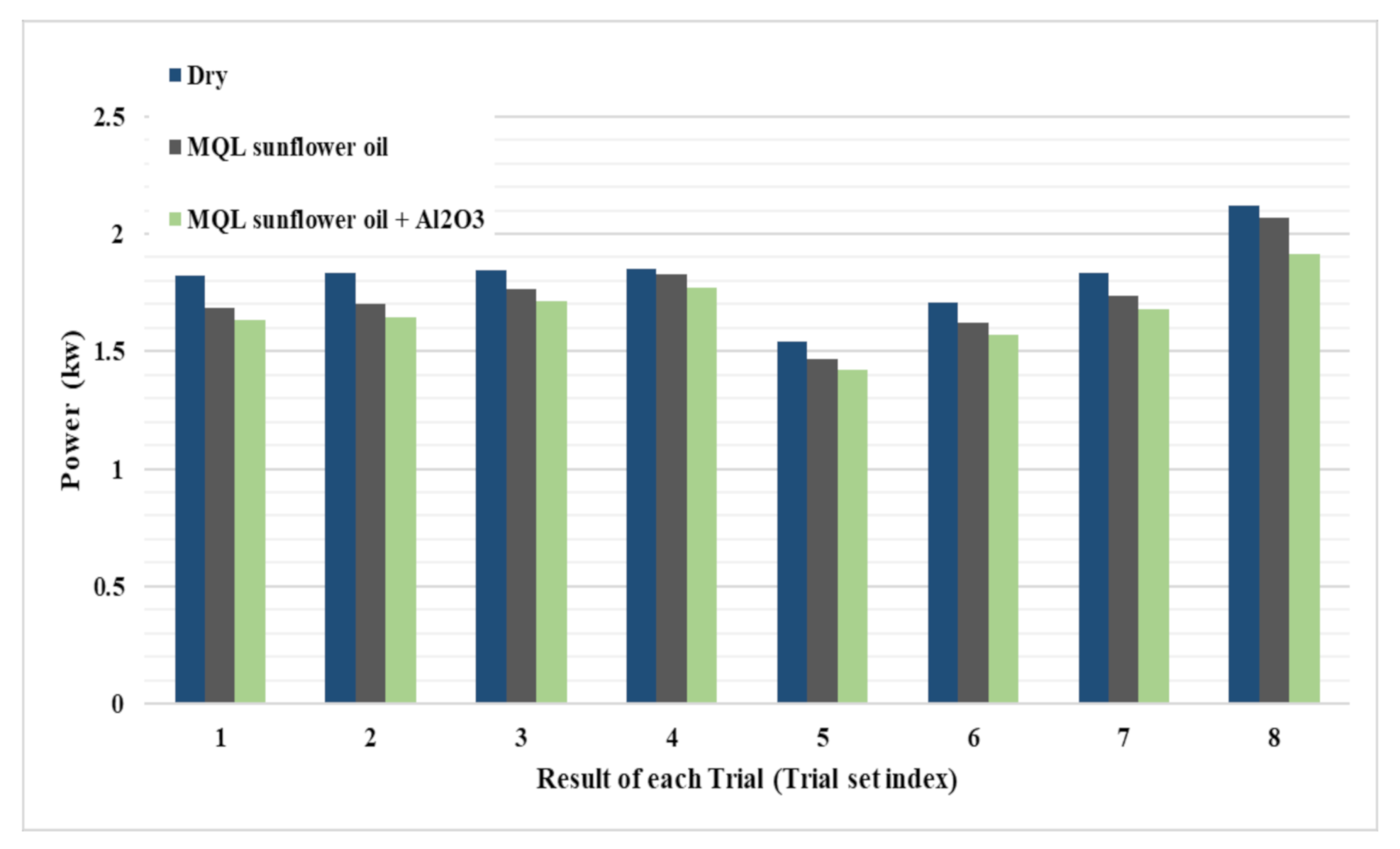
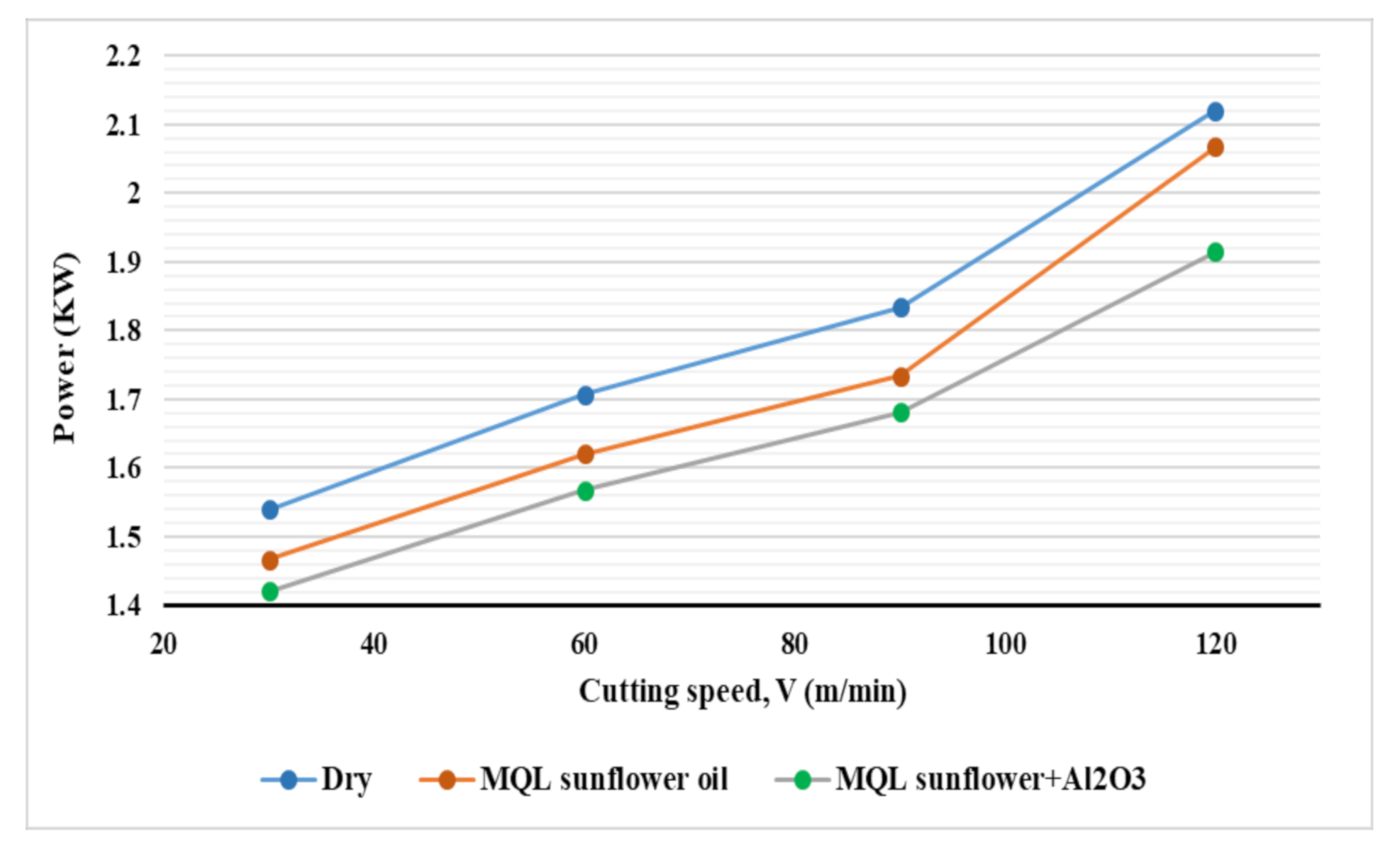
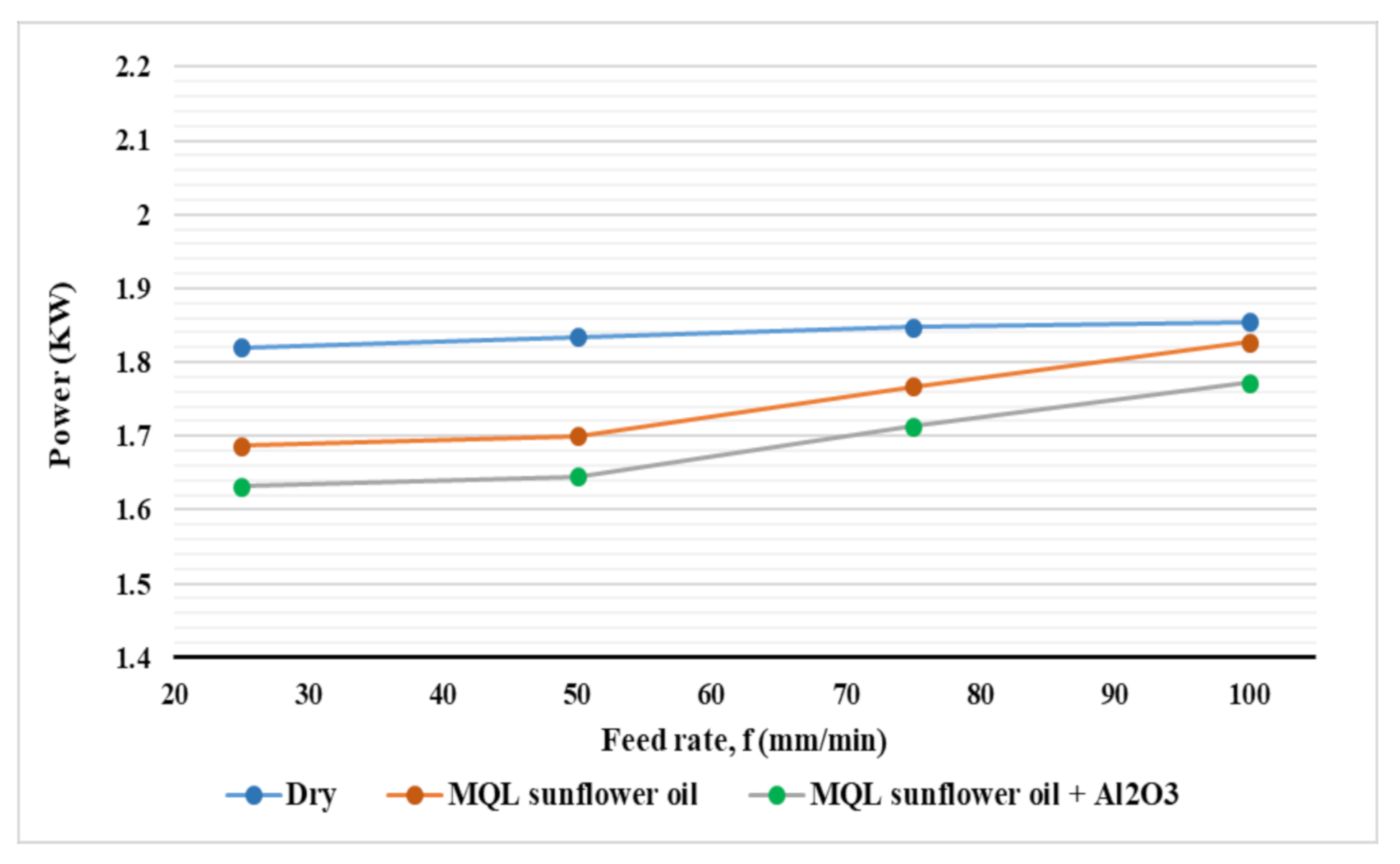
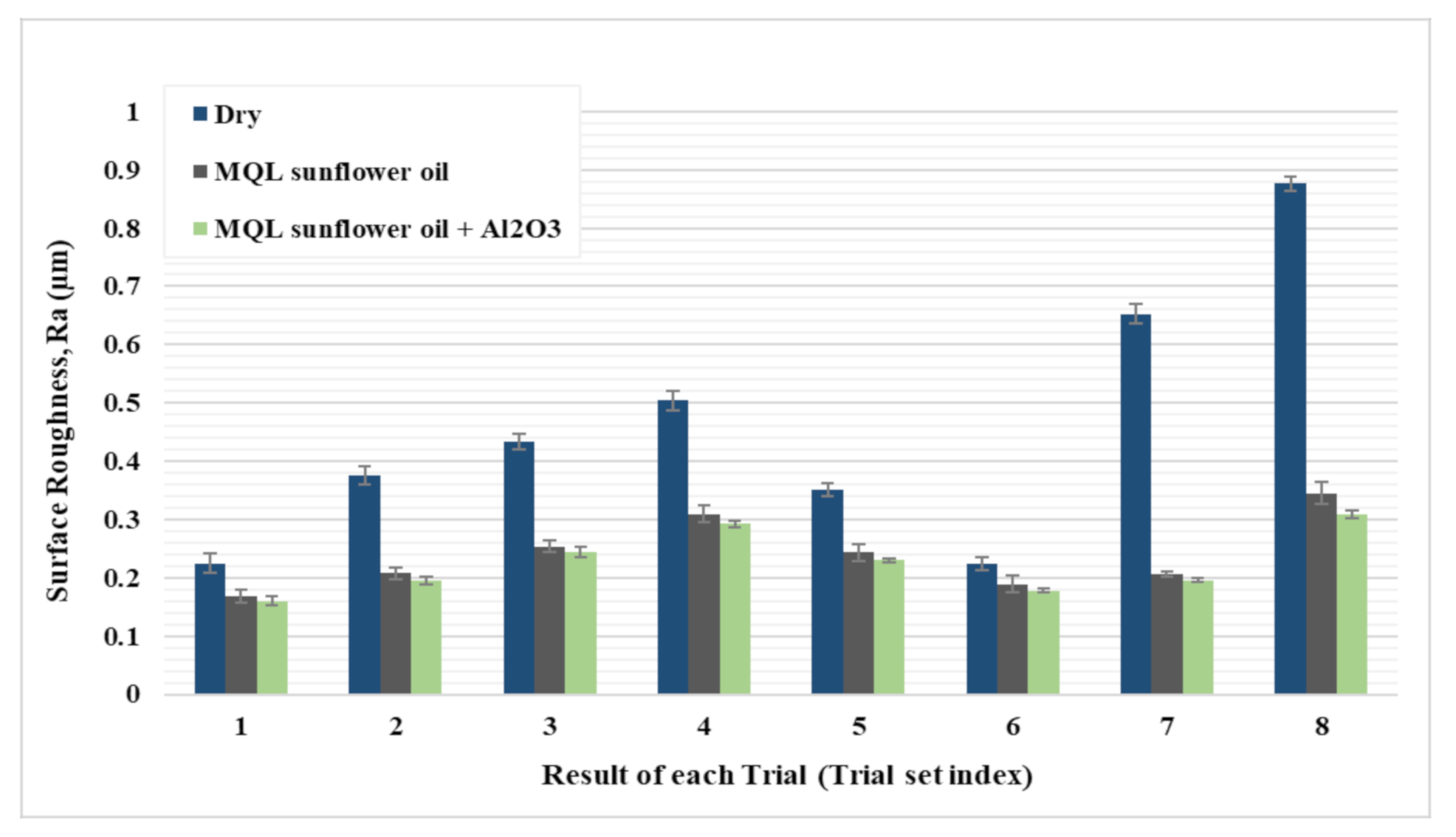

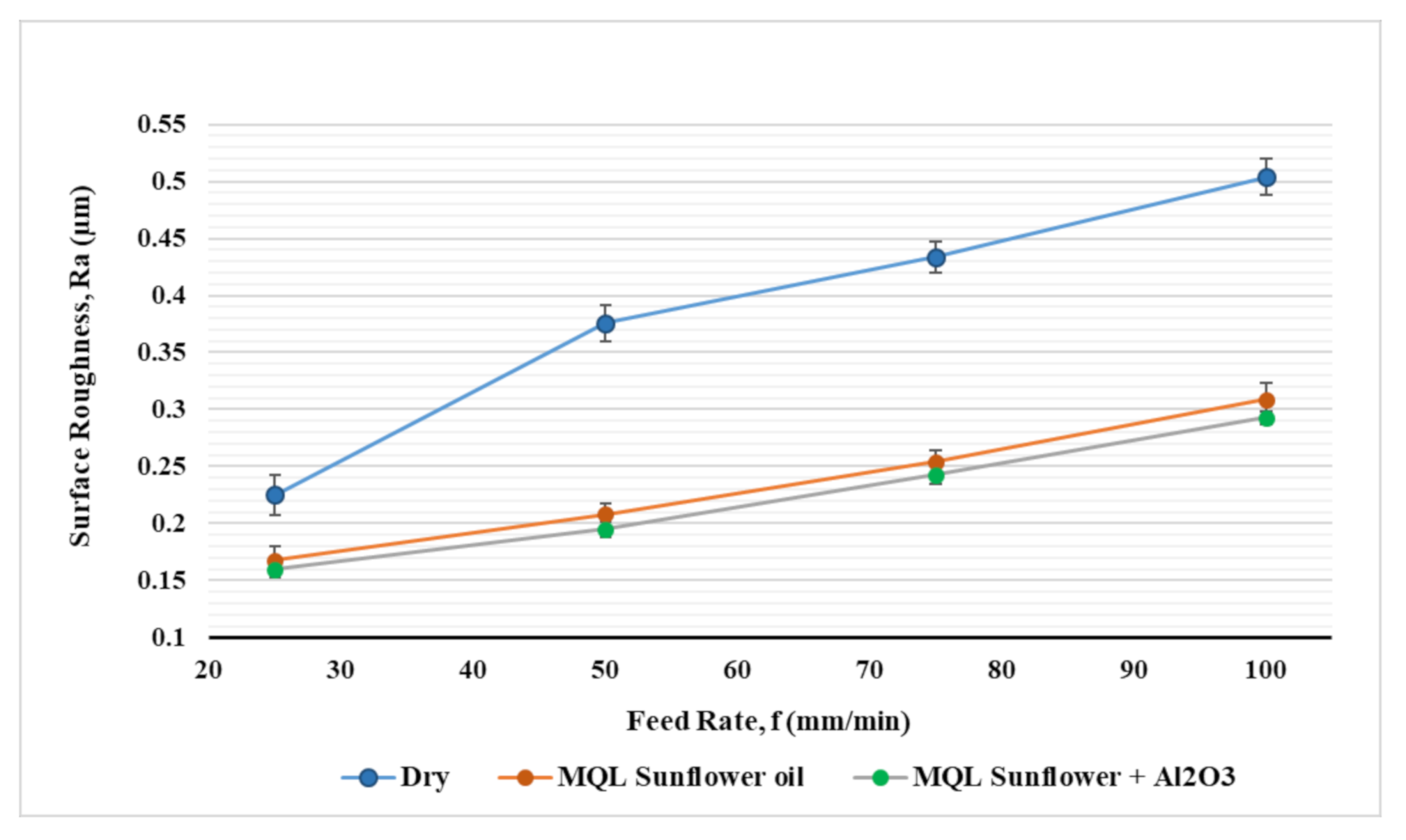

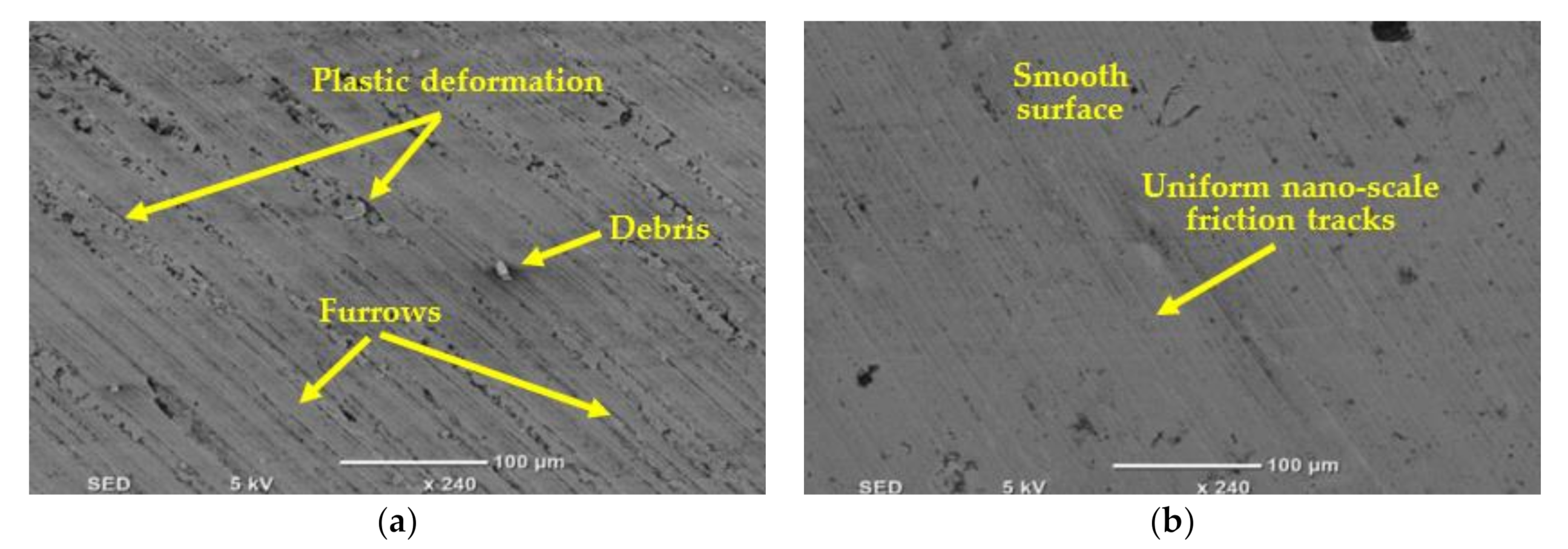
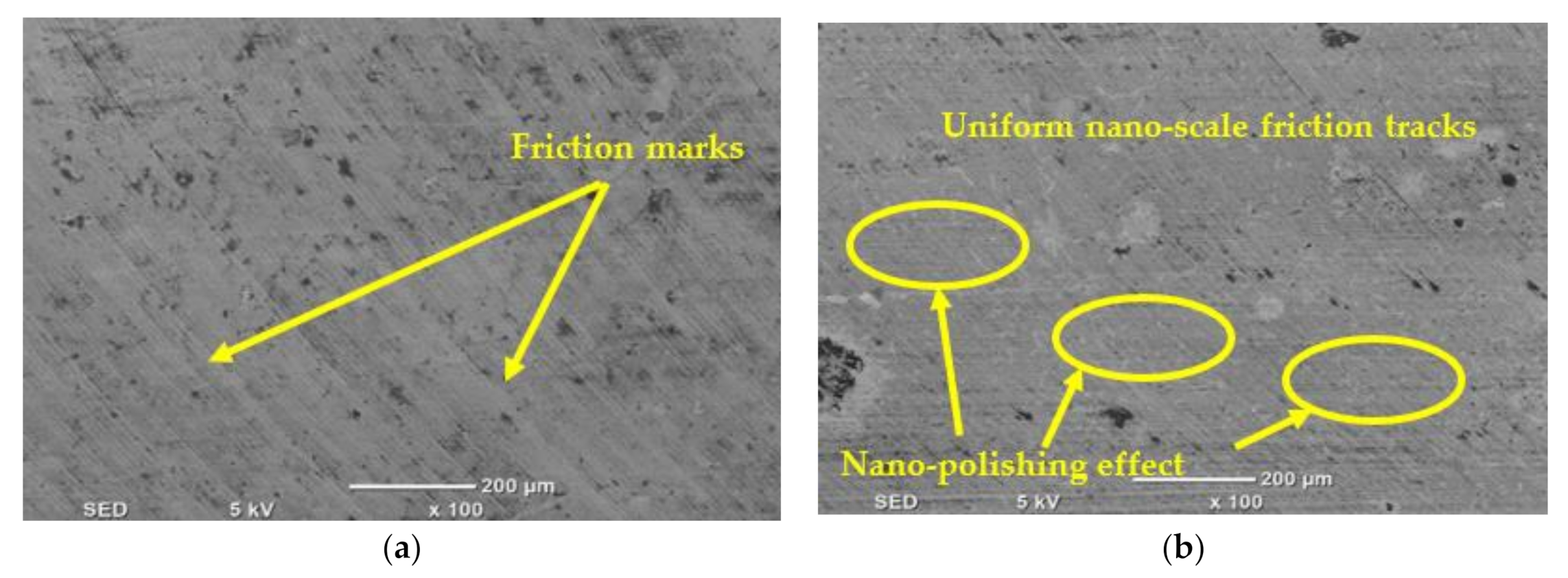
| C. | Cr | Mn | Mo | Ni | P | S | Si | V |
|---|---|---|---|---|---|---|---|---|
| 0.077 | 17.125 | 1.974 | 1.853 | 10.177 | 0.0004 | 0.005 | 0.489 | 0.0615 |
| Mechanical Properties | Value |
|---|---|
| Ultimate Tensile Strength | 520 N/mm2 |
| 0.2% Proof Strength | 208 N/mm2 |
| Elongation (in length 51 mm) | 40% |
| Modulus of Elasticity | 200 GPa |
| Modulus of Shear | 82 GPa |
| Hardness | 215 HB |
| Cutting Conditions | Value |
|---|---|
| Cutting Diameter | 12 mm |
| Cutting Length | 24 mm |
| Number of Flutes | 4 |
| Axial Depth | 0.75 mm |
| Radial Depth | 4 mm |
| Trial # | Cutting Speed, V (m/min) | Feed Rate, f (mm/min) | Chip Load per Flute (mm/tooth) | Dry | Sunflower Oil MQL Coolant | Sunflower Oil + Nano Al2O3-Based MQL Coolant | |||
|---|---|---|---|---|---|---|---|---|---|
| Ra µm | Power KW | Ra µm | Power KW | Ra µm | Power KW | ||||
| 1 | 50 | 25 | 0.0047 | 0.224 | 1.820 | 0.169 | 1.687 | 0.161 | 1.632 |
| 2 | 50 | 50 | 0.0094 | 0.375 | 1.834 | 0.209 | 1.700 | 0.196 | 1.645 |
| 3 | 50 | 75 | 0.0141 | 0.436 | 1.847 | 0.257 | 1.767 | 0.243 | 1.713 |
| 4 | 50 | 100 | 0.0188 | 0.505 | 1.854 | 0.311 | 1.827 | 0.294 | 1.772 |
| 5 | 30 | 50 | 0.0157 | 0.351 | 1.540 | 0.244 | 1.467 | 0.231 | 1.421 |
| 6 | 60 | 50 | 0.0079 | 0.227 | 1.707 | 0.188 | 1.620 | 0.179 | 1.568 |
| 7 | 90 | 50 | 0.0052 | 0.657 | 1.834 | 0.207 | 1.734 | 0.197 | 1.681 |
| 8 | 120 | 50 | 0.0039 | 0.877 | 2.120 | 0.346 | 2.067 | 0.310 | 1.915 |
Publisher’s Note: MDPI stays neutral with regard to jurisdictional claims in published maps and institutional affiliations. |
© 2021 by the authors. Licensee MDPI, Basel, Switzerland. This article is an open access article distributed under the terms and conditions of the Creative Commons Attribution (CC BY) license (http://creativecommons.org/licenses/by/4.0/).
Share and Cite
Abbas, A.T.; Anwar, S.; Abdelnasser, E.; Luqman, M.; Qudeiri, J.E.A.; Elkaseer, A. Effect of Different Cooling Strategies on Surface Quality and Power Consumption in Finishing End Milling of Stainless Steel 316. Materials 2021, 14, 903. https://doi.org/10.3390/ma14040903
Abbas AT, Anwar S, Abdelnasser E, Luqman M, Qudeiri JEA, Elkaseer A. Effect of Different Cooling Strategies on Surface Quality and Power Consumption in Finishing End Milling of Stainless Steel 316. Materials. 2021; 14(4):903. https://doi.org/10.3390/ma14040903
Chicago/Turabian StyleAbbas, Adel T., Saqib Anwar, Elshaimaa Abdelnasser, Monis Luqman, Jaber E. Abu Qudeiri, and Ahmed Elkaseer. 2021. "Effect of Different Cooling Strategies on Surface Quality and Power Consumption in Finishing End Milling of Stainless Steel 316" Materials 14, no. 4: 903. https://doi.org/10.3390/ma14040903
APA StyleAbbas, A. T., Anwar, S., Abdelnasser, E., Luqman, M., Qudeiri, J. E. A., & Elkaseer, A. (2021). Effect of Different Cooling Strategies on Surface Quality and Power Consumption in Finishing End Milling of Stainless Steel 316. Materials, 14(4), 903. https://doi.org/10.3390/ma14040903








